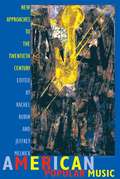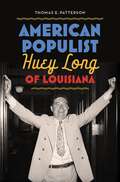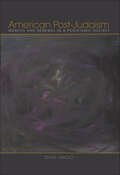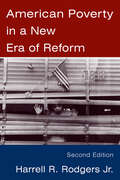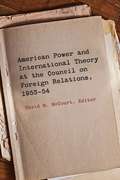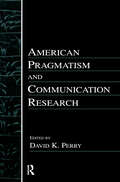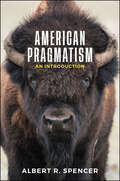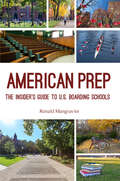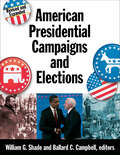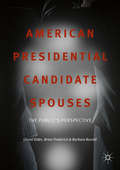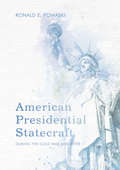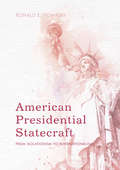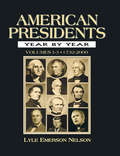- Table View
- List View
American Popular Music: From Minstrelsy To Mp3
by Larry Starr Christopher WatermanIn American Popular Music: From Minstrelsy to MP3, Second Edition, Larry Starr and Christopher Waterman examine popular music in the United States from its beginnings into the 21st century, offering a comprehensive look at the music, the cultural history of the times, and the connections between them. Using well-chosen examples, insightful commentaries, and an engaging writing style, this text traces the development of jazz, blues, country, rock, Motown, hip-hop, and other popular styles,highlighting the contributions of diverse groups to the creation of distinctly American styles. It combines an in-depth treatment of the music itself--including discussions of stylistic elements and analyses of musical examples--with solid coverage of the music's attendant historical, social, and cultural circumstances. The authors incorporate strong pedagogy including numerous boxed inserts on significant individuals, recordings, and intriguing topics; coverage of early American popular music; and a rich illustration program. Detailed listening charts explain the most important elements of recordings discussed at length in the text. The charts are complemented by two in-text audio CDs and--new to this edition--an iMix published at iTunes, which makes most of the songs immediately available to students and instructors. Features of the Second Edition * Integrates full color throughout * Provides more coverage of women artists, with new material on women in rock 'n' roll inChapter 8 and a box on Queen Latifah in Chapter 14 * Reorganizes the discussion of post-1970s music: disco is now included with mainstream 70s pop, while hip-hop is treated in two chapters (12 and 14) in order to emphasize its significance and diversity * Adds new material on the recent alternative country music explosion * Includes new developments in music technology in the thoroughly revised concluding chapter * Offers revised and more vivid visual elements, including more than 100 new photos (most in full color) and an illustrated timeline * Provides redesigned listening guides, enhanced by an iMix published at iTunes (accessible at www. oup. com/us/popmusic) * Supplemented by a Companion Website at www. oup. com/us/popmusic (containing both student and instructor resources) and an Instructor's Manual and a Computerized Test Bank on CD * FREE with the purchase of this book: a 6-month subscription to Grove Music Online (www. grovemusic. com)--a $180 value Remarkably accessible,American Popular Music, Second Edition, is ideal for courses in American Popular Music, the History of Popular Music, Popular Music in American Culture, and the History of Rock 'n' Roll. Its welcoming style and warm tone will captivate readers, encouraging them to become more critically aware listeners of popular music.
American Popular Music: From Minstrelsy to MP3
by Larry Starr Christopher Waterman Brad OsbornExplore the rich terrain of American popular music with the most complete introduction of its kind. With the sixth edition of the bestselling text American Popular Music: From Minstrelsy to MP3, Starr and Waterman help students hear more in the music around them with a cultural and social history of popular music.
American Popular Music: From Minstrelsy to MP3
by Larry Starr Christopher WatermanExplore the rich terrain of American popular music with the most complete, colorful, and authoritative introduction of its kind. In the fifth edition of their best-selling text, American Popular Music: From Minstrelsy to MP3, Larry Starr and Christopher Waterman provide a unique combination of cultural and social history with the analytical study of musical styles.
American Popular Music: New Approaches to the Twentieth Century
by Jeffrey Melnick Rachel RubinDesigned as a broad introductory survey, and written by experts in the field, this book examines the rise of American music over the 20th century - the period in which that music came into its own and achieved unprecedented popularity. Beginning with a look at music as a business, 11 essays explore a variety of popular musical genres, including Tin Pan Alley, blues, jazz, country, gospel, rhythm and blues, rock and roll, folk, rap, and Mexican American corridos. Reading these essays, we come to see that the forms created by one group often appeal to, and are in turn influenced by, other groups - across lines of race, ethnicity, class, gender, region and age. The chapters speak to one another, arguing for the primacy of such concepts as minstrelry, urbanization, hybridity and crossover as the most powerful tools for understanding American popular music. Moving beyond outdated music-industry categories and misleading genre labels, while acknowledging the complexities of the market, the book recovers and reinforces the essential blackness of much popular music - even a presumably white form like country and western.
American Populist: Huey Long of Louisiana
by Thomas E. PattersonThomas E. Patterson’s monumental biography of Huey Long is a profound reevaluation of his life and legacy, recognizing him as an inspirational progressive thinker, populist hero, and radical influence on the New Deal before an assassin’s bullet ended his life in 1935. First as governor and then as U.S. senator, Long transformed the politics of Louisiana by standing for the interests of citizens whom state officials had historically ignored. He eased suffrage restrictions so that more people could vote, and voters endorsed his program of more robust government services and shifting the tax burden to those better able to pay. In the United States Senate, during the darkest days of the Great Depression, he advocated loudly and ceaselessly for the redistribution of wealth, expanding public works, increasing the money supply, insuring bank deposits, paying old-age pensions and veterans’ benefits, delivering a minimum income for families, and funding college and vocational education. President Franklin D. Roosevelt, along with other politicians and pundits, dismissed Long’s proposals as nonsense put forth by a reckless demagogue in search of votes. Despite several biographies, acclaimed novels, and historical studies in the years since Long’s death, his reputation today is mostly caricature: a spellbinding speaker, a dictator, a populist firebrand who was unprincipled and corrupt. Using previously untapped personal papers of Long and his son Russell, other primary sources, recent scholarship, and his experience as a lawyer, Patterson provides a necessary corrective as he analyzes the contours of Long’s career, deconstructs the elements of his success, undercuts several myths related to his time in office, and explains the circumstances that led to his ultimate downfall. The result is the most comprehensive, balanced, and analytical study of the Kingfish to date.
American Portrait: The Story of Us, Told by Us
by PBSBased on the popular and revolutionary PBS multiplatform documentary project, an inspiring and striking photographic portrait that brilliantly captures the tumultuous, historic year that was 2020, offering an intimate look at the heart and soul of our national life and what it means to be an American today, revealed through the stories of ordinary people from sea to shining sea.Everyone has a story . . . In January 2020, in celebration of its 50th anniversary, PBS launched an ambitious national storytelling project, American Portrait, inviting people across the country to participate in a national conversation about what it means to be an American today. The multiplatform experience, including a television series that will air on PBS stations nationwide in January 2021, has created a communal voice through the individual stories of participants—each one a unique stitch in the beautiful, diverse quilt that is America. A vivid yet nuanced snapshot of who we are, this visually striking companion volume features more than 400 entries and photographs, all which began with an answer to a simple cue: My American story started when . . .You don’t know what it’s like to . . .My greatest challenge is . . . The tradition I carry on is . . . I was raised to believe . . . What keeps me up at night is . . .I took a risk when . . .When I step outside my door . . . Most days I feel . . . Told by people of all ages, orientations, and walks of life, these unique stories of joy, adversity, love, sacrifice, grief, sharing, triumph, and grace, centered on the themes of family, work, fun, faith, and community, illuminate the struggles, hopes, dreams, and convictions of Americans today. The more we share with our fellow citizens, the more we can see a real, complex, and fascinating representation of our country that is far richer and deeper than headlines and elections tell us. As intriguing, thoughtful, and distinct as the nation it embodies, American Portrait is a photographic manifestation of Walt Whitman’s immortal words, “I am large. I contain multitudes”—and a vital and ultimately hopeful reminder that what we all share is much greater and enduring than what may divide us.
American Post-Judaism: Identity and Renewal in a Postethnic Society (Religion in North America)
by Shaul MagidHow do American Jews identify as both Jewish and American? American Post-Judaism argues that Zionism and the Holocaust, two anchors of contemporary American Jewish identity, will no longer be centers of identity formation for future generations of American Jews. Shaul Magid articulates a new, post-ethnic American Jewishness. He discusses pragmatism and spirituality, monotheism and post-monotheism, Jesus, Jewish law, sainthood and self-realization, and the meaning of the Holocaust for those who have never known survivors. Magid presents Jewish Renewal as a movement that takes this radical cultural transition seriously in its strivings for a new era in Jewish thought and practice.
American Postmodernist Fiction and the Past
by Theophilus SavvasThrough a close-reading of the work of five prominent American postmodernist writers, this book re-evaluates the role of the past in recent American fiction, outlines the development of the postmodernist historical novel and considers the waning influence of postmodernism in contemporary American literature.
American Poverty in a New Era of Reform
by Harrell R. RodgersThis new edition of American Poverty in a New Era of Reform provides a comprehensive examination of the extent, causes, effects, and costs of American poverty nearly ten years after the passage of the Personal Responsibility and Work Opportunity Reconciliation Act (PRWORA) in 1996. The author includes the most current available demographic, budget, evaluation, and program data to evaluate the impact of this sweeping legislation on federal and state policies, as well as on poverty populations. This revised edition takes into account the economic slowdown that took place in 2001 through 2003. It examines the state decisions about how to implement PRWORA, and how changes have affected the poverty population and overall welfare system. The author identifies the positive implications of welfare reform along with problems that must be addressed. New features for this edition include an appendix of Internet sources a state-by-state tables of poverty rates.
American Power after the Financial Crisis
by Jonathan KirshnerThe global financial crisis of 2007–2008 was both an economic catastrophe and a watershed event in world politics. In American Power after the Financial Crisis, Jonathan Kirshner explains how the crisis altered the international balance of power, affecting the patterns and pulse of world politics. The crisis, Kirshner argues, brought about an end to what he identifies as the "second postwar American order" because it undermined the legitimacy of the economic ideas that underpinned that order—especially those that encouraged and even insisted upon uninhibited financial deregulation. The crisis also accelerated two existing trends: the relative erosion of the power and political influence of the United States and the increased political influence of other states, most notably, but not exclusively, China. Looking ahead, Kirshner anticipates a “New Heterogeneity” in thinking about how best to manage domestic and international money and finance. These divergences—such as varying assessments of and reactions to newly visible vulnerabilities in the American economy and changing attitudes about the long-term appeal of the dollar—will offer a bold challenge to the United States and its essentially unchanged disposition toward financial policy and regulation. This New Heterogeneity will contribute to greater discord among nations about how best to manage the global economy. A provocative look at how the 2007–2008 economic collapse diminished U.S. dominance in world politics, American Power after the Financial Crisis suggests that the most significant and lasting impact of the crisis and the Great Recession will be the inability of the United States to enforce its political and economic priorities on an increasingly recalcitrant world.
American Power and International Theory at the Council on Foreign Relations, 1953-54
by David M McCourtBetween December 1953 and June 1954, the elite think-tank the Council on Foreign Relations (CFR) joined prominent figures in International Relations, including Pennsylvania’s Robert Strausz-Hupé, Yale’s Arnold Wolfers, the Rockefeller Foundation’s William Thompson, government adviser Dorothy Fosdick, and nuclear strategist William Kaufmann. They spent seven meetings assessing approaches to world politics—from the “realist” theory of Hans Morgenthau to theories of imperialism of Karl Marx and V.I. Lenin—to discern basic elements of a theory of international relations. The study group’s materials are an indispensable window to the development of IR theory, illuminating the seeds of the theory-practice nexus in Cold War U.S. foreign policy. Historians of International Relations recently revised the standard narrative of the field’s origins, showing that IR witnessed a sharp turn to theoretical consideration of international politics beginning around 1950, and remained preoccupied with theory. Taking place in 1953–54, the CFR study group represents a vital snapshot of this shift. This book situates the CFR study group in its historical and historiographical contexts, and offers a biographical analysis of the participants. It includes seven preparatory papers on diverse theoretical approaches, penned by former Berkeley political scientist George A. Lipsky, followed by the digest of discussions from the study group meetings. American Power and International Theory at the Council on Foreign Relations, 1953–54 offers new insights into the early development of IR as well as the thinking of prominent elites in the early years of the Cold War.
American Pragmatism and Communication Research (Routledge Communication Series)
by David K. PerryThis monograph examines the past, present, and potential relationship between American pragmatism and communication research. The contributors provide a bridge between communication studies and philosophy, subjects often developed somewhat in isolation from each other. Addressing topics, such as qualitative and quantitative research, ethics, media research, and feminist studies, the chapters in this volume: *discuss how a pragmatic, Darwinian approach to inquiry has guided and might further guide communication research; *advocate a functional view of communication, based on Dewey's mature notion of transaction; *articulate a pragmatist's aesthetics and connect it to Deweyan democracy; *discuss the similarities and differences between Dewey's notion of inquiry and the philosophical hermeneutics of Hans-Georg Gadamer; *apply accommodation theory, linked to symbolic interactionism and more generally to the social behaviorism of George H. Mead and his followers, to media research; *interpret media-effects evidence in light of pragmatist ideas about inquiry; and *argue that pragmatism theorizes about despair and life's sense of the tragic. This book is written to be readily accessible to students and professional academics within and outside the field of communication studies without extensive training in specialized areas of communication study.
American Pragmatism and Organization: Issues and Controversies
by Nick RumensEmerging during the late nineteenth century in the diverse scholarship of US commentators such as Charles Sanders Peirce, William James and John Dewey, American pragmatism shaped many intellectual currents within a range of disciplines including politics, education, administrative science and religion. Despite attracting attention and interest due to its conceptualization of theory, in terms of its practical consequences for improving the human condition, American pragmatism struggled to maintain its influence and suffered a hiatus until it experienced a renaissance within scholarly circles during the 1970s. While renewed interest in American pragmatism continues to grow, with some scholars distinguishing between classical, neo and new forms of pragmatism, it is only relatively recently that organization studies scholars have drawn upon American pragmatist philosophies for shedding new light on aspects of contemporary organizational life. This edited collection builds on this emergent literature in an engaging and scholarly manner. American Pragmatism and Organization is a ground-breaking collection and distinctive in its book-length treatment of American pragmatism as a relevant resource for analysing organisations. It draws together an international body of research focused on the interconnections and interplay between American pragmatism and organizational phenomena, explores the theoretical possibilities afforded by pragmatist thinking for understanding organization, and illuminates the practical advantages of doing so.
American Pragmatism: An Introduction
by Albert R. SpencerIn this comprehensive introduction, Albert Spencer presents a new story of the origins and development of American pragmatism, from its emergence through the interaction of European and Indigenous American cultures to its contemporary status as a diverse, vibrant, and contested global philosophy. Spencer explores the intellectual legacies of American pragmatism’s founders, Peirce and James, but also those of newly canonical figures such as Addams, Anzaldúa, Cordova, DuBois, and others crucial to its development. He presents the diversity of pragmatisms, old and new, by weaving together familiar and unfamiliar authors through shared themes, such as fallibilism, meliorism, pluralism, verification, and hope. Throughout, Spencer reveals American pragmatism's engagement with the consequences of US political hegemony, as versions of pragmatism arise in response to both the tragic legacies and the complicated benefits of colonialism. American Pragmatism is an indispensable guide for undergraduate students taking courses in pragmatism or American philosophy, for scholars wishing to develop their understanding of this thriving philosophical tradition, or for curious readers interested in the genealogy of American thought.
American Pravda: My Fight for Truth in the Era of Fake News
by James O'KeefeThe one real difference between the American press and the Soviet state newspaper Pravda was that the Russian people knew they were being lied to. To expose the lies our media tell us today, controversial journalist James O’Keefe created Project Veritas, an independent news organization whose reporters go where traditional journalists dare not. Their investigative work–equal parts James Bond, Mike Wallace, and Saul Alinsky—has had a consistent and powerful impact on its targets.In American Pravda, the reader is invited to go undercover with these intrepid journalists as they infiltrate political campaigns, unmask dishonest officials and expose voter fraud. A rollicking adventure story on one level, the book also serves as a treatise on modern media, arguing that establishment journalists have a vested interest in keeping the powerful comfortable and the people misinformed.The book not only contests the false narratives frequently put forth by corporate media, it documents the consequences of telling the truth in a world that does not necessarily want to hear it. O’Keefe’s enemies attack with lawsuits, smear campaigns, political prosecutions, and false charges in an effort to shut down Project Veritas. For O’Keefe, every one of these attacks is a sign of success.American Pravda puts the myths and misconceptions surrounding O’Keefe’s activities to rest and will make you rethink every word you hear and read in the so-called mainstream press.
American Predator: The Hunt for the Most Meticulous Serial Killer of the 21st Century
by Maureen CallahanA Los Angeles Times "Seven Highly Anticipated Books for Summer Reading"A USA Today "20 of the Season's Hottest New Books"A New York Post "25 Best Beach Reads of 2019 You Need to Pre-Order Now" "Maureen Callahan's deft reporting and stylish writing have created one of the all-time-great serial-killer books: sensitive, chilling, and completely impossible to put down." --Ada Calhoun, author of St. Marks Is Dead Ted Bundy. John Wayne Gacy. Jeffrey Dahmer. The names of notorious serial killers are usually well-known; they echo in the news and in public consciousness. But most people have never heard of Israel Keyes, one of the most ambitious and terrifying serial killers in modern history. The FBI considered his behavior unprecedented. Described by a prosecutor as "a force of pure evil," Keyes was a predator who struck all over the United States. He buried "kill kits"--cash, weapons, and body-disposal tools--in remote locations across the country. Over the course of fourteen years, Keyes would fly to a city, rent a car, and drive thousands of miles in order to use his kits. He would break into a stranger's house, abduct his victims in broad daylight, and kill and dispose of them in mere hours. And then he would return home to Alaska, resuming life as a quiet, reliable construction worker devoted to his only daughter.When journalist Maureen Callahan first heard about Israel Keyes in 2012, she was captivated by how a killer of this magnitude could go undetected by law enforcement for over a decade. And so began a project that consumed her for the next several years--uncovering the true story behind how the FBI ultimately caught Israel Keyes, and trying to understand what it means for a killer like Keyes to exist. A killer who left a path of monstrous, randomly committed crimes in his wake--many of which remain unsolved to this day.American Predator is the ambitious culmination of years of interviews with key figures in law enforcement and in Keyes's life, and research uncovered from classified FBI files. Callahan takes us on a journey into the chilling, nightmarish mind of a relentless killer, and to the limitations of traditional law enforcement.
American Prep: The Insider's Guide to U.S. Boarding Schools
by Ronald Mangravite#1 Best Seller in High School Test Preparation, SSAT & COOP - Comprehensive boarding school guideWhat is boarding school really like?What are my chances of getting into U.S. boarding schools?How do I evaluate private schools vs. public schools?What is boarding school really like? U.S. boarding schools offer a superb preparation for college bound students, but they are not for everyone. American Prep is the only comprehensive guide for parents and students interested in investigating, applying to, and succeeding at these great schools. Meticulously researched and thoughtfully written, American Prep is an essential guide through the world of U.S. boarding schools – their history and culture, their resources and support systems, their opportunities and challenges – and the only book that leads you through the entire prep school experience. You will learn about:Why boarding schools are increasingly valuable in the 21st centuryThe pros and cons of private school vs public schoolHow to select a school that is right for your student and your familyHow to navigate the admission process – detailed insider adviceThe emotional challenges of prep school for students and families – what to expect and whenHow to secure generous financial aid for prep schoolStudent success on campus – getting in is only the first stepAn insider's perspective on U.S. boarding schools: Award winning writer/critic Ronald Mangravite has multiple perspectives on the American prep school world. An alumnus of the Lawrenceville School, he is a current prep school parent, an alumni class officer, and an admissions volunteer. His extensive teaching experience includes universities and private schools, with service on admissions and curricula committees. He holds degrees from the University of California, Berkeley and UCLA.
American Presidential Campaigns and Elections: Gilded Age Politics And The Front Porch Campaign Of 1888 (American Presidential Elections Ser.)
by Lewis L. Gould Brooks D. Simpson Robert W. Cherny James C. Bradford David E. Long Jeffrey L. Pasley Stuart Leibiger William G. Shade Frank Davis Ballard C. Campbell David Brian Robertson Mary C. Brennan Michael A. Morrison Andrew W. Robertson Michael J. Birkner Melanie Gustafson Julie Walsh Maureen A. Flanagan Brett Flehinger Dante J. Scala Philip Payne Mark Voss-Hubbard Richard M. Valelly WILLIAM G. SHADE; BALLARD C. CAMPBELL Craig R. Coenen Jonathan M. Atkins Judith A. Best Charles Calhoun Frank Colon Herbert B. Ershkowitz Todd A. Estes William A. Gudelunas Peter Knupfer Dean Kotlowski Philip J. Lampi Alan Lessoff James Mott Lynn H. Parsons Keith Ian Polakoff John W. Quist Patrick D. Reagan Jeff Singleton Mark W. Summers Philip R. VanderMeer Melanie Shell Weiss Jeffrey Randall WoodsPresidential campaigns and elections provide the drama and substance of America's democratic process. As democracy in action, they punctuate our nation's history in precise intervals, capturing the issues, the ideas, and the mood of the nation every four years. Every/campaign follows a similar format: candidates jockey for selection, nominations are made, candidates and party leaders hit the trail, and voters render their decision on Election Day. Yet despite this familiar process, every campaign is unique, featuring colorful personalities and unexpected events. This fully illustrated reference is packed with facts and information on every campaign from the election of 1788-89 through the hotly contested election of 2000. Each entry traces in detail the background and results of the election, provides biographical information on every presidential and vice-presidential candidate, and offers state-by-state tallies of every election. The set also features hundreds of rarely seen documents associated with the campaigns.
American Presidential Candidate Spouses: The Public's Perspective
by Brian Frederick Laurel Elder Barbara BurrellThe book offers a comprehensive analysis of public opinion toward presidential candidate spouses over the course of three decades, drawing on multiple theoretical frameworks including the concept of “new traditionalism” and a plethora of empirical data to explore why some spouses engender greater support than others—and what these reactions reveal about the American public and the gendered nature of the American presidency. Recognizing that presidential candidate spouses are important but understudied political actors, this book provides extensive analysis of public evaluations of Bill Clinton and Melania Trump during the 2016 presidential election as well as the presidential candidate spouses in the 1992 and 2012 elections and places public reaction to these individuals in historical context. The book considers important trends in U.S. elections including party polarization from the distinctive vantage points of candidate spouses and explores the symbolic importance of historic firsts including the first African American candidate spouse and the first male candidate spouse. No other work provides a systematic exploration of public opinion towards candidate spouses as distinct political entities across the modern political era.
American Presidential Power and the War on Terror: Does The Constitution Matter?
by Justin DePlatoThis book examines the use of presidential power during the War on Terror. Justin DePlato joins the debate on whether the Constitution matters in determining how each branch of the federal government should use its power to combat the War on Terror. The actions and words of Presidents George W. Bush and Barack Obama are examined. DePlato's findings support the theory that executives use their own prerogative in determining what emergency powers are and how to use them. According to DePlato, the Presidents argue that their powers are implied in Article II of the Constitution, not expressed. This conclusion renders the Constitution meaningless in times of crisis. The author reveals that Presidents are becoming increasingly cavalier and that the nation should consider adopting an amendment to the Constitution to proffer expressed executive emergency powers.
American Presidential Statecraft: During the Cold War and After
by Ronald E. PowaskiThis book, the second of two volumes, examines the presidency in last half of twentieth century America and explores the successes and failures of presidents in their foreign policy initiatives. It examines each president's ability to apply his skills to a foreign policy issue in the face of opposition that may come from a variety of sources, including the Congress, the Pentagon, the State Department, the press, and often their own in-house advisers. This volume in particular focuses on John F. Kennedy, Lyndon Johnson, Richard Nixon, Ronald Reagan, and George W. Bush.
American Presidential Statecraft: From Isolationism to Internationalism
by Ronald E. PowaskiThis book, the second of two volumes, examines the presidency in last half of twentieth century America and explores the successes and failures of presidents in their foreign policy initiatives. It examines each president's ability to apply his skills to a foreign policy issue in the face of opposition that may come from a variety of sources, including the Congress, the Pentagon, the State Department, the press, and often their own in-house advisers. This volume in particular focuses on John F. Kennedy, Lyndon Johnson, Richard Nixon, Ronald Reagan, and George W. Bush.
American Presidents Year by Year
by Julie NelsonThis fascinating multi-volume set illuminates the panorama of American history through the personal and professional stories of the nation's presidents. Arranged chronologically, and covering George Washington to George W. Bush, it juxtaposes the lives of each year's current, former, and future living presidents against each other and the historical backdrop of their times. Each chapter opens with a summary of the year and describes the major issues and events the incumbent president faced. Separate sections within each chapter - "Former Presidents" and "Future Presidents" - detail important developments in the lives of past and future presidents month by month during that same year, highlighting political, social, and personal decisions that helped shape the course of American history.
American Presidents and Israeli Settlements since 1967 (Routledge Studies in US Foreign Policy)
by Michael F. CairoTracing presidential administrations since Lyndon B. Johnson, this book argues that the Trump administration's policy toward Israeli settlements in the West Bank and Jerusalem is not an aberration, but the culmination of over fifty years of American foreign policy. Under the Johnson administration, the United States rhetorically supported the applicability of international law regarding Israeli settlements. However, throughout the 1970s, administrations did little to reverse the construction and expansion of settlements. Moreover, presidents sent mixed signals regarding Israel's withdrawal from the occupied territories. The Israeli settlement movement received support when Reagan argued that settlements were not illegal. Since then, American presidents have opposed settlement activity to various degrees, but not based on their illegality. Rather, presidents have described them as unwise, unhelpful, or obstacles to peace. Even when presidents have had opportunities to confront Israeli settlements directly, domestic pressure and America's special relationship with Israel have prevented serious action beyond rhetoric and condemnation. This volume will be of interest to scholars and students of the history and politics of American foreign policy, American relations with Israel, and the Israeli-Palestinian conflict.
American Presidents and the United Nations: Internationalism in the Balance
by Jerry Pubantz John Allphin Moore, Jr.American Presidents and the United Nations: Internationalism in the Balance offers a fresh look at the U.S.–UN relationship. The current discourse regarding America’s linkage with the UN—and particularly about the President’s influence on the world body—has metamorphosed well beyond the conventional conversation of the post-World War II generation. This book places the UN–U.S. relationship within the evolving fabric of international affairs and American political developments through the 2020 presidential election, into the early Biden administration. The text integrates analyses of individual presidential politics and presidential foreign policy preferences from Franklin Roosevelt through Donald Trump, with congressional responses, and seemingly ever-accelerating, troublesome, and often unanticipated international crises. Readers will find the latest scholarship, primary sourcing, as well as synthesis, and a fresh analysis of the ongoing and increasingly multifaceted political and intellectual debate about America’s role in the world. The book spotlights one of the most creative, complex, and inspirited global institutions ever devised by human beings—the United Nations—and puts it in context with the powerful role of the American presidency. Essential for students, scholars, and general readers alike.



